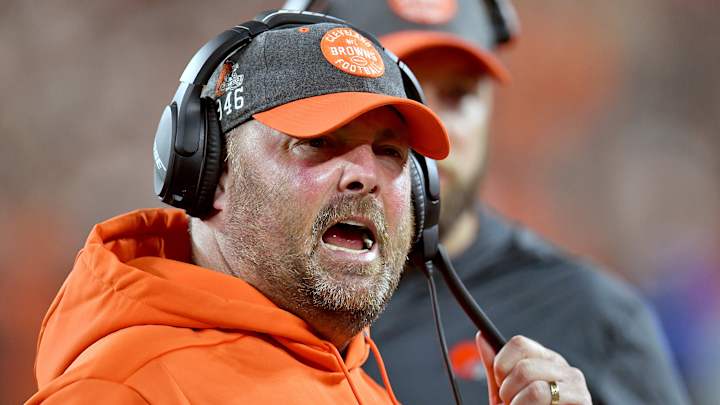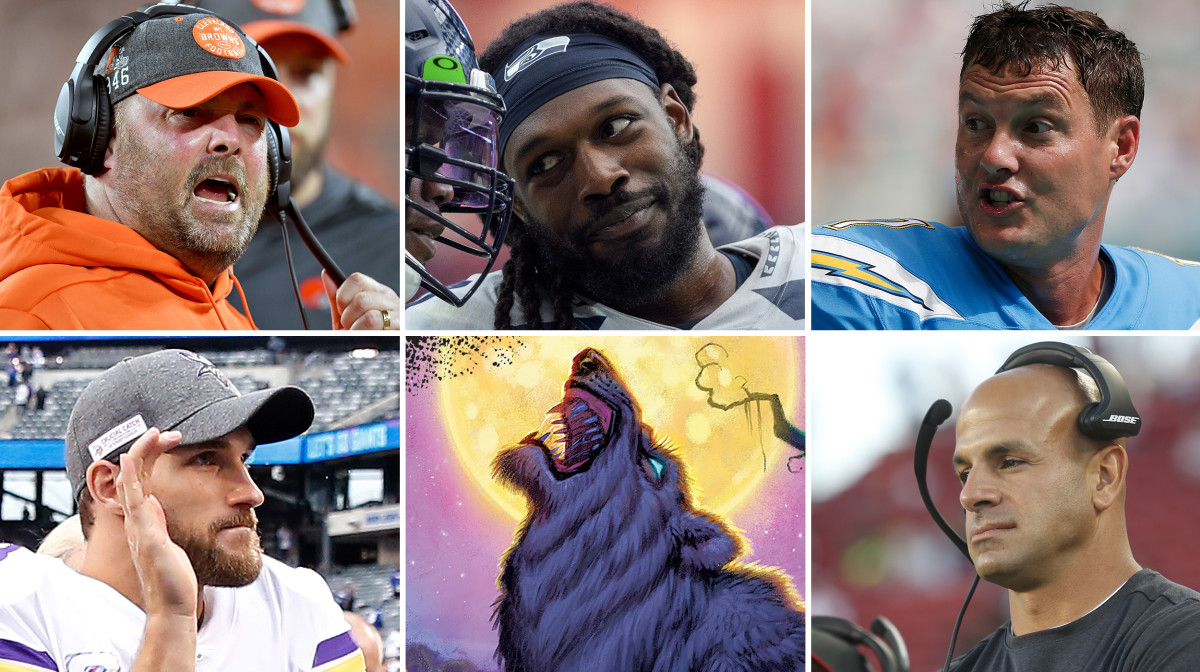Freddie Kitchens’s Cleveland Nightmare, and Who’s Getting Lucky in the Red Zone?


1. If there’s one thing that should keep Freddie Kitchens up at night, it’s those R.L. Stine Goosebumps books he’s been reading right before bed. (Is the monster in “The Werewolf of Fever Swamp” a werewolf? A swamp creature? A precursor to some kind of 12 Monkeys-style pandemic? I don’t know because I’ve never read those books, but I bet Freddie Kitchens wishes he had never found out, even if everyone was cool with leaving the nightlight on.)
Kitchens’s biggest concern during his waking hours should be the fact that his offense, his quarterback, and his flawed roster don’t mesh. Cleveland’s O-line has been deteriorating since the last regime’s fateful, foolish decision to let Mitchell Schwartz and Alex Mack walk rather than paying market value to retain them during the tanktastic years. It left them relying on the draft to address a position group that is arguably the most difficult to rebuild through the draft (hello Cameron Erving, Shon Coleman and Austin Corbett). In their one acceptable performance of 2019, the Browns held up O.K. against a Baltimore pass-rush that relies more on those Wink Martindale overload blitzes than outstanding individual talent. When the Browns have faced a four-man pass rush that just gets after it the results have been ugly, whether it’s been Cameron Wake, Aaron Donald or Nick Bosa. On Sunday, it will be Jadeveon Clowney and a good—not great—Seahawks pass rush coming to Cleveland.
Kitchens—perhaps stubbornly—is not implementing much in the way of a quick-strike passing game to work around it. It’s not unlike the situation the Texans have been in the last two seasons, with the offensive line overmatched on a weekly basis and Bill O’Brien sticking to a lot of those slow-developing iso-routes. A year ago, Houston worked around it, in part, by keeping an eligible receiver in to help in pass protection. But the Texans can deal with it mostly because of Deshaun Watson’s preternatural ability to deal with pressure, navigate his way through a swarm of pass-rushers and keep his eyes upfield while doing it.
Baker Mayfield, on the other hand, is now in the habit of drifting back in the face of the rush—and, quite troublingly, sometimes in the face of no pressure. Not only is he busting up play designs with this habit (no one’s passing designs are built around a quarterback drifting 10 yards behind the line of scrimmage), but he’s putting himself in position to attempt throws that should only be tried by those ranking in the Patrick Mahomes/Josh Allen range of the arm talent scale. Mayfield has a good arm, but accuracy and mental acuity (storage space and processing speed) are his true strengths. None of those matter when he’s immediately swallowed up by a pass rush play after play after play.
There’s enough skill-position talent—Odell Beckham Jr. can make something out of nothing every now and then—to steal a few more games this season. But because of how the offensive line is constructed, there has to be a different schematic solution for the Browns.
* * *
2. I keep a spreadsheet that keeps a running standing of my favorite spreadsheets in the world. That spreadsheet, of course, ranks No. 1—try to keep up. But every year around this time, my Expected Red Zone Performance spreadsheet rises to the second spot.
Here’s what you need to know about red zone performance: (1) It’s incredibly important, and (2) For every team in the league, performance seems to fluctuate almost randomly from year to year. Small sample size is a big reason for that. But the red zone is simply a different game, the field condensed, with both risk and reward rising exponentially in that area of the field.
You’ll see some different metrics for red zone performance—TD efficiency is one, and that’s all well and good. But TD efficiency doesn’t recognize that a field goal is better than a turnover (just ask the Lions after that loss to K.C.), and it also doesn’t factor in how many trips to the red zone a team makes. The metric I use is a team’s red-zone points over expected red zone points (based on the league average points per red-zone trip—4.74 per trip, through five weeks—since, again red-zone success seems to be random).
For instance, right now, the Seahawks offense has scored 104 points in the red zone over 17 red-zone trips (14 touchdowns, 3 field goals). If they were league-average in the red zone (which you’d “expect” every team to be), that number would be 85 points. Thus, the Seahawks are a league-high 3.7 points per game above expected offensive red-zone performance. Yes, they have Russell Wilson and Russell Wilson is good. But over the past five years, the Seahawks offense has ranked 7th, 16th, 26th, 12th, and 16th in points per red zone trip. Don’t try to make sense of it, just stop being a jerkwad and believe me: Aside from a team like the Miami Dolphins, who every Sunday this season will dump a pile of soggy aquamarine towels onto the field and call it a professional football team, every team should be expected to hover around the league average in red-zone performance.
ERGO! Once you factor in red zone defensive performance (same deal as above), you can figure out who has had the top red-zone point differential vs. expected red-zone point differential. In other words, here’s who’s had the most—and least—red-zone luck five NFL weeks into The Year of the Lord 2019:
1. Philadelphia, +4.56 points per game
2. Seattle, +4.25
3. Dallas, +3.24
4. Green Bay, +2.91
5. Chicago, +2.79
[LOTS OF OTHER TEAMS, 22 TO BE EXACT]
28. N.Y. Jets, –2.46
29. New Orleans, –2.50
30. Cincinnati, –3.06
31. L.A. Chargers, –3.78
32. Sentient Pile of Diapers Claiming to be the Miami Dolphins, –8.41(!)
I want to focus in on the Chargers, who have been in four one-possession games and lost three of them. Once they move back toward the mean—which you’d expect for every team save the Dolphins—that should turn more close losses into close wins. Ditto the Bengals, who stink but have also lost three games by four points or less. They could easily be sitting at 2-3 or even 3-2 right now.
You’d think the 3-2 Eagles would be in for a win-loss regression, but maybe not: They’re 2-2 in one-possession games this year, and those particular red-zone numbers are skewed by the Packers’ red-zone meltdowns on Thursday night two weeks ago. So Eagles fans can get off my back. They’re going to win the Super Bowl anyway, once they trade for a cornerback.
* * *
3. The Dolphins have been outscored 81-0 in the second half of games this season. To put that in perspective, imagine one point 81 times.
* * *
4. There are a few things working against the 49ers on Sunday—particularly, the fact that they’re on the road on a short week while the Rams had three extra days to prepare for a monster NFC West showdown. Still, this feels like we could be on the verge of a changing of the guard in that division.
In three meaningful matchups (throw out the 2017 regular-season finale when the Rams sat all their starters) with Robert Saleh’s 49ers defense, Sean McVay’s Rams have put up 41, 39 and 48 points. But these teams are so much different on both sides of the ball this time around. Saleh (who, by the way, should be a head coach in three months or so) finally has the big-time pass-rush his defense needs, with Nick Bosa and Dee Ford joining DeForest Buckner in what could be football’s best defensive line by the end of the year. Meanwhile, while the gawking rabble is all abuzz over the absence of Todd Gurley, the real problem in L.A. is that the Rams have not found suitable replacements for guard Rodger Saffold and center John Sullivan. Center Brian Allen and guards Joseph Noteboom and Austin Blythe have formed an interior that surely has Elsie de Wolfe spinning in her grave. That’s why the 2019 Rams have been a pale imitation of the first two McVay iterations.
McVay is still one of the best schemers in football, and having an extra three days to plan for a familiar foe (especially one still short-handed in the secondary) could do wonders for the Rams.
* * *
5. The Helmet Cam is coming back! And hopefully we’ll have them for live games soon.
Will it infringe on my pending patent to scotch-tape discarded iPhone 4s onto the facemask? That’s for the courts to decide.
* * *
6. The Eagles don’t have anyone who can cover the Vikings’ wide receivers. The Eagles’ pass-rush also hasn’t been able to recapture their glory days, giving a bad Vikings offensive line (that phrase is redundant) a chance. But, more than anything, in this game, against a fellow NFC contender, with a talent advantage in the passing game, in his own building, Kirk Cousins has to deliver a signature win.
* * *
7. Ladies and gentlemen . . . Superchunk!
• Question or comment? Email us at talkback@themmqb.com.
